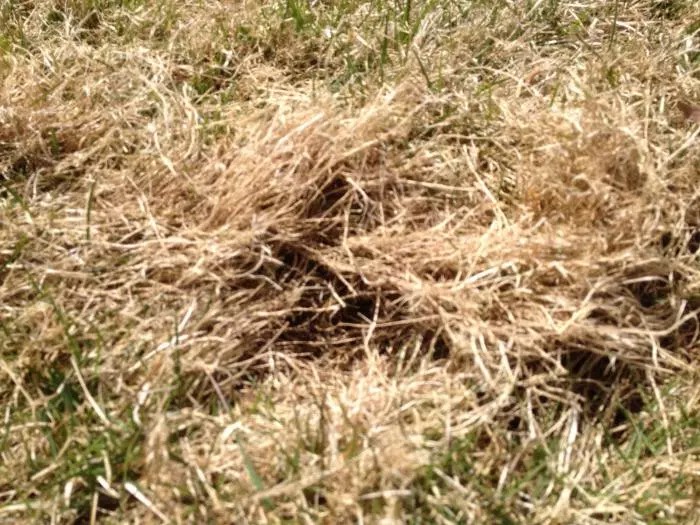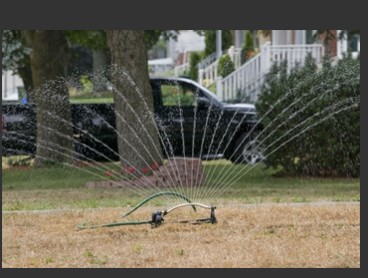Turf King owner Gerry admits that he’s never seen a summer like this in his decades of experience in the lawn care business. Despite the conditions, however, he said homeowners still have cause for hope.
“Grasses are genetically capable of withstanding drought conditions, to a point,” he said. “They will go dormant when it’s dry and then, when the fall rains come, lawns will pick up and start to turn green.”
Gerry said a healthy lawn treated with a high-potassium fertilizer has the best chance of beating the heat. His best advice, however, is a little more unconventional.
“Instead of watering the lawn, wash the car,” he said. “That’ll make it rain.”
Here is the complete article ...
http://www.thespec.com/news/local/article/570062--turf-trauma
Thanks for the heads up, Bill
A customer sent an email about Bent Grass
"Also, you have identified "Bent Grass" in our lawn that we wanted to eradicate. Could your company assist us in identifying these areas, as we would like to remove this grass and re-sod the affected area(s). Does your company do re-sodding work? If so, would it also be possible to get a price for removing and re-sodding the affected areas? Could the bent grass be coming via our lawn cutting contractors using the same mower elsewhere and on our property as well?
Thank you for any help you can provide"
Brian
Bent grass can arrive on a lawn in a number of ways. It grows in parks, meadows etc. So birds may ingest the seeds and drop them onto your lawn. It also means they can arrive in soil and manures.
Bent grass can propagate itselves by the stems. Bent grass stems often lie above the soil. (Kentucky bluegrass stems are below the soil surface.) A stem landing in the right spot and receiving enough moisture can grow roots and create a new plant. In fact, many times, the stems lying on the soil surface will have small roots starting. So a piece of bent grass arriving via a lawn mower is another possibility. It also means that once on your lawn, it can spread by stems being mowed and moved from place to place.
Bent grass can also be a contaminant in grass seed. It's easy to keep dandelion seeds out of grass seed mixtures, because the field of grasses grown for seed (mostly in Oregon) can be sprayed for broadleaf weeds. It is harder to treat them for undesirable grasses as a treatment is more likely to damage the crop.
Bent grass is not easy to eradicate. No treatments are likely to consistently work. Some old and new herbicides claim they will damage bent grass, but in these cases "Murphy's Law" applies. When you don't want to damage bent grass, you can be sure it will be damaged! If you apply a treatment to knock the bent grass out, it never seems to work
To control creeping bent grass without using chemicals, maintain turf density and health through proper cultural practices. This means: Avoid overwatering, over fertilization and close mowing. Mow to a height of 2 ½ to 3 inches and remove no more than 1/3 of the turf grass blades at each mowing.
When thinking about getting rid of bent grass, it is also worthwhile to evaluate the lawn conditions. Bent grass likes moist conditions. Sometimes areas that are low and subject to moisture pooling or retention are more likely to have bent grass. It is worthwhile to raise the level of the lawn in those areas, if possible, to reduce the risk of re-infection.
To get rid of bent grass in a lawn that has a major infestation, the best way at present is to rent a sod cutter and remove any patches of the bent grass and then re-sod. Since bent grass is shallow-rooted, a sod cutter should remove most of the roots.
Afterwards, maintain a close eye on the lawn and remove any patches of bent grass when they first appear and are small. If this is done a in the spring and fall, the bent grass should have minimal opportunity to spread.
A Photo of Bentgrass in early spring-

Suzanne asks on Facebook
Can you please post on WHEN and HOW MUCH is the best time to water your lawn in this heat wave?
In a drought, lawns still need 1.5 (one and a half) inches of water per week. This is the best way to measure how much you are watering. I prefer to give them a good soaking all at once, rather than in small doses; in other words, once a week, rather than every day. Early morning is best since there will be less water lost to evaporation. If you carefully look at your lawn, you can see the signs of drought stress. The grass blades will tend to fold up to preserve moisture. The look of the lawn will be different.
see general watering guidelines in Lawn Library.












